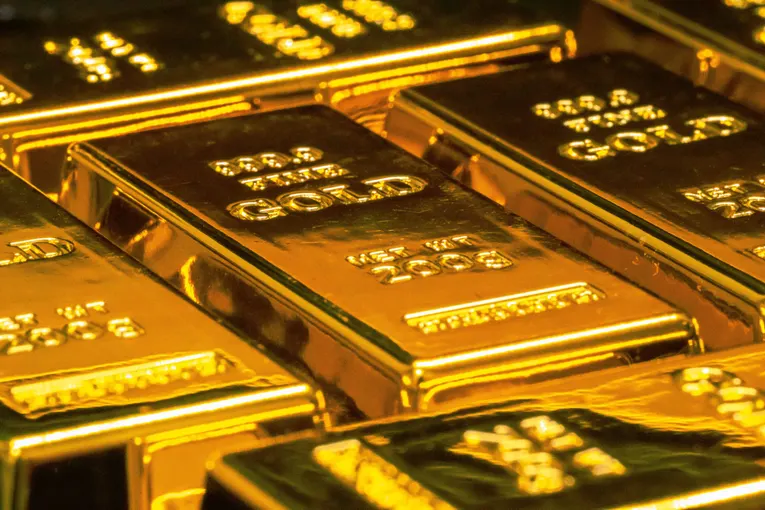
Gold is really important in India. People use it for weddings and festivals because it’s considered lucky. It’s also a popular way for people to save money because it keeps its value over time. So, in India, gold is not just shiny, it’s like a symbol of wealth and good fortune.
Currently the rate of a gold in India is ₹ 6,715 per gram for 22 karat gold and for 24 karat gold is ₹ 7,325 per gram.(also called 999 gold ).
Table of Contents

About Gold India
India has a rich history with gold, spanning thousands of years. One significant detail is India’s cultural affinity and traditional significance attached to gold. Gold is not just considered a valuable metal for investment or adornment; it holds deep cultural, religious, and social importance in Indian society.
In India, gold is often associated with prosperity, purity, and auspiciousness. It is an integral part of religious ceremonies, festivals, weddings, and other significant occasions. For example, during festivals like Diwali and Dhanteras, it is customary for people to buy gold jewelry or coins as a symbol of good fortune and wealth.
Moreover, gold plays a crucial role in Indian weddings and is considered a symbol of the bride’s wealth and status. Families often invest in gold jewelry as part of their daughter’s dowry, which is then passed down through generations.
India is also one of the largest consumers of gold globally, with a significant portion of the population investing in physical gold as a form of savings and security. The country’s love for gold is evident in its consumption patterns, with demand for gold jewelry, coins, and bars remaining consistently high.
Overall, the relationship between India and gold goes beyond its economic value; it is deeply ingrained in the cultural, social, and religious fabric of the nation.
About Gold
Gold: An Icon of Value and Symbolism
Gold, throughout history, has held a mystique and allure unlike any other metal. Its rarity, malleability, and inherent beauty have made it not only a symbol of wealth and prosperity but also a cornerstone of human culture, economy, and technology. Let’s delve into the multifaceted nature of gold, exploring its significance in economics, history, technology, and culture.
Economics:
1. Store of Value:
Gold has been a store of value for millennia. Unlike fiat currencies, which can lose value due to inflation or government policies, gold maintains its worth over time. Central banks and investors often hedge against economic uncertainty by holding significant reserves of gold.
2. Investment:
Gold serves as an investment asset, offering diversification benefits and serving as a hedge against inflation and currency depreciation. Investors purchase gold in various forms, including physical gold (bars, coins, jewelry) and financial instruments such as gold-backed exchange-traded funds (ETFs) and futures contracts.
3. Economic Indicators:
Gold prices are closely monitored as an economic indicator. Fluctuations in gold prices can signal shifts in market sentiment, inflation expectations, geopolitical tensions, and currency movements. Analysts often use gold prices as a barometer of global economic health.
History:
1. Ancient Civilizations:
Ancient civilizations revered gold for its rarity and beauty. Gold artifacts dating back thousands of years have been discovered in archaeological excavations, showcasing its significance in cultures such as ancient Egypt, Mesopotamia, Greece, and Rome. Gold coins emerged as early forms of currency, facilitating trade and commerce.
2. Gold Rushes:
The discovery of gold deposits has sparked numerous gold rushes throughout history. The California Gold Rush of the 19th century and the Klondike Gold Rush in Canada are notable examples, attracting thousands of prospectors in search of fortune and leading to significant social and economic transformations in those regions.
3. Gold Standards:
Gold played a central role in the international monetary system until the 20th century. The gold standard, where currencies were pegged to a specific quantity of gold, provided stability to global finance. While the gold standard has largely been abandoned, its legacy continues to influence monetary policies and debates.
Technology:
1. Electronics:
Gold’s excellent conductivity and resistance to corrosion make it indispensable in electronics manufacturing. It is used in circuitry, connectors, and components of electronic devices such as smartphones, computers, and medical equipment. The miniaturization of electronic devices has increased the demand for gold in microelectronics.
2. Aerospace and Medicine:
Gold’s biocompatibility and inertness make it suitable for various medical and aerospace applications. It is used in implants, medical devices, and spacecraft components due to its non-reactive nature and ability to withstand extreme conditions. Gold nanoparticles have promising applications in cancer treatment and diagnostic imaging.
3. Nanotechnology:
Gold nanoparticles exhibit unique optical, electronic, and catalytic properties at the nanoscale. They are extensively studied for applications in sensors, diagnostics, drug delivery, and renewable energy technologies. Gold nanomaterials hold potential for revolutionizing industries and addressing global challenges.
Culture:
1. Symbolism:
Gold is imbued with symbolism in diverse cultures and religions worldwide. It represents wealth, purity, and divinity in many traditions. Gold artifacts, jewelry, and ornaments are integral to rituals, ceremonies, and celebrations, signifying prosperity, status, and blessings.
2. Art and Craftsmanship:
Gold has inspired artists and craftsmen across centuries, resulting in exquisite works of art and craftsmanship. From ancient sculptures and religious artifacts to Renaissance paintings and contemporary jewelry designs, gold continues to be a medium for expressing creativity, skill, and cultural identity.
3. Tradition and Ritual:
Rituals associated with gold, such as weddings, religious offerings, and ceremonial adornment, are deeply ingrained in cultural practices worldwide. Gold jewelry, coins, and ornaments are passed down through generations, symbolizing familial bonds, heritage, and auspicious beginnings.
FAQs
1. What is gold?
Gold is a chemical element with the symbol Au (from the Latin “aurum”) and atomic number 79. It is a dense, soft, shiny, and malleable metal with a bright yellow color. Gold is prized for its rarity, beauty, and versatility, making it one of the most valuable and sought-after metals in human history.
2. How is gold formed?
Gold is primarily formed through supernova nucleosynthesis, where heavier elements are created within stars through nuclear fusion processes. These elements are then scattered into space when the star explodes in a supernova event. Over billions of years, these dispersed elements coalesce into celestial bodies, including Earth. Gold deposits are found in various geological formations, often associated with quartz veins, placer deposits, and hydrothermal systems.
3. What are the uses of gold?
Gold has numerous practical applications across industries and sectors, including:
- Jewelry and adornment: Gold is widely used in jewelry for its beauty, durability, and resistance to tarnishing.
- Investment: Gold serves as a store of value and a hedge against inflation and economic uncertainty.
- Electronics: Gold’s excellent conductivity and corrosion resistance make it essential in electronics manufacturing.
- Aerospace and medicine: Gold is utilized in aerospace components, medical devices, and treatments due to its biocompatibility and inertness.
- Nanotechnology: Gold nanoparticles have diverse applications in sensors, diagnostics, drug delivery, and renewable energy technologies.
4. How is gold mined?
Gold mining involves various techniques depending on the geological characteristics of the deposit. Common methods include:
- Open-pit mining: Large-scale excavation of surface deposits using heavy machinery.
- Underground mining: Extracting gold from deep underground veins or ore bodies through tunnels and shafts.
- Placer mining: Collecting gold particles from streambeds or alluvial deposits using simple tools such as pans and sluice boxes.
- Heap leaching: Extracting gold from low-grade ores by piling crushed ore on a leach pad and using cyanide solution to dissolve the gold.
5. What factors influence the price of gold?
The price of gold is influenced by various factors, including:
- Economic indicators: Inflation, interest rates, currency strength, and economic stability affect gold prices.
- Geopolitical tensions: Political instability, conflicts, and uncertainty drive investors to seek safe-haven assets like gold.
- Supply and demand: Changes in gold production, central bank reserves, and investor sentiment impact supply and demand dynamics.
- Market speculation: Speculative trading, investor sentiment, and macroeconomic trends can cause short-term fluctuations in gold prices.
6. How can I invest in gold?
There are several ways to invest in gold, including:
- Physical gold: Buying gold bars, coins, or jewelry from reputable dealers or mints for direct ownership.
- Gold ETFs: Investing in exchange-traded funds (ETFs) backed by physical gold, which are traded on stock exchanges.
- Gold futures and options: Speculating on the future price of gold through derivative contracts traded on commodity exchanges.
- Gold mining stocks: Purchasing shares of gold mining companies to gain exposure to gold prices and mining operations.
7. Is gold a good investment?
Gold can serve as a diversification tool and a hedge against economic uncertainty, inflation, and currency devaluation. However, like any investment, gold carries risks and may not always perform well compared to other assets. It’s essential to consider your investment objectives, risk tolerance, and portfolio allocation before investing in gold.
8. What are the environmental impacts of gold mining?
Gold mining can have significant environmental impacts, including habitat destruction, water pollution, deforestation, and carbon emissions. Practices such as open-pit mining, cyanide leaching, and mercury use can harm ecosystems and local communities. Sustainable mining practices and responsible regulations are essential to minimize environmental degradation and promote social responsibility in the gold mining industry.
9. What is the history of gold as currency?
Gold has been used as a form of currency and medium of exchange for thousands of years. Ancient civilizations such as the Egyptians, Greeks, and Romans minted gold coins for trade and commerce. The gold standard, where currencies were pegged to a specific quantity of gold, was prevalent in the 19th and early 20th centuries. While the gold standard has largely been abandoned, gold’s role in the global monetary system continues to influence central bank reserves and monetary policies.
10. How does gold compare to other precious metals?
Gold is often compared to other precious metals such as silver, platinum, and palladium. Each metal has unique properties, uses, and market dynamics. Gold is valued for its rarity, liquidity, and cultural significance, while silver is used in industry and investment. Platinum and palladium are primarily industrial metals, with significant demand in automotive catalytic converters and jewelry manufacturing. Investors may diversify their portfolios by allocating investments across various precious metals based on their risk-return profiles and market conditions.
Conclusion:
Gold’s enduring appeal transcends its tangible value; it encompasses history, culture, economics, and technology. As humanity continues to evolve, the allure of gold persists, reflecting our collective aspirations, achievements, and aspirations. Whether as an investment asset, a technological marvel, or a cultural treasure, gold remains an icon of enduring value and symbolism in the human experience.




![Ellora Caves [ 600 – 1000 ] AD](https://supremebulletnews.com/wp-content/uploads/2024/06/Untitled-design-15.png)

